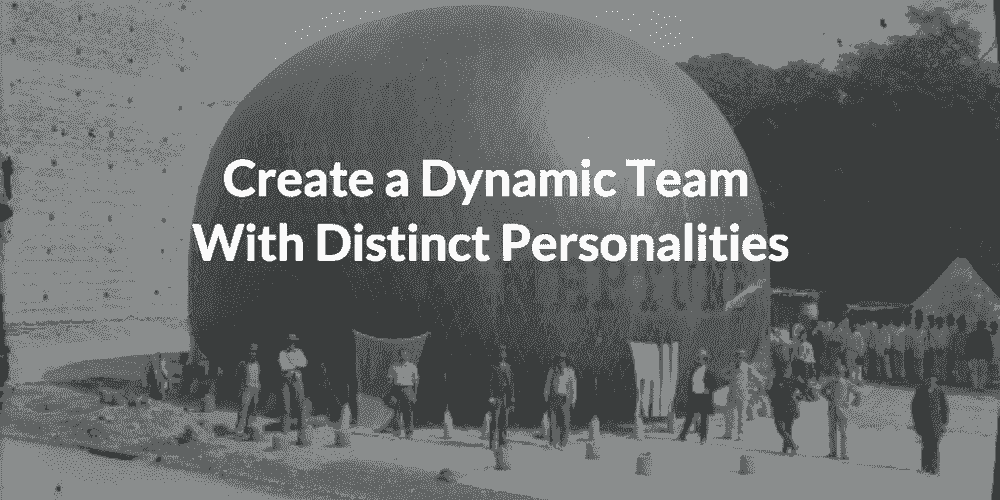December 1st, 2017
They say teamwork makes the dream work. But can you actually create a dreamlike work environment with your teammates?
Yes, absolutely. It is possible, but it won’t magically fall into place. You have to actively create the team you need.
Here’s the thing: A lot of team leaders build a team based on personal preference and who they’d prefer to have a beer with. They stack their team with people who are similar to them and lose out on having a diverse set of skills and ideas. We don’t want to admit it but we’re much more likely to hire someone that’s like us. It’s natural. An extroverted leader would rather work with an outgoing, never-met-a-stranger type. If you’re an extroverted person, do you really want to hire an introverted, no-small-talking, socially awkward guy?
It may feel unnatural but the truth is, you do. And here’s why:
While the overly extroverted type has a place on your team (especially in a customer-facing position), you wouldn’t want an entire team of them. You need a diverse group of people who help each other because they excel in different areas. The extroverted type generally doesn’t want to do TPS reports and write out proposals. They’re much better at negotiating deals and making the magic happen.
That said, there’s another person on your team. This person loves getting into the nitty-gritty but can’t small-talk to save their life. They make a different type of magic happen, and it’s a concoction of spreadsheet formulas and work systems that create a secure foundation for your project.
You may not hang out after the work’s done, but you need both types of people (and more) to create an effective team.
If everyone thinks in the same way, you won’t be able to grow.
A lot of team leaders make the mistake of choosing teammates with whom they’d like to actually be friends. The thinking is, If I can hang out with this person, we can share the same vision.
But the problem is, when you surround yourself with people who think just like you, you won’t grow beyond your own boundaries because there’s no one to:
- challenge you and your ideas
- implement your ideas
- expand on your ideas
- evangelize your ideas
Rarely will you find one person who can do all of the above. Even if you do, you certainly won’t find an entire team that can. And why would you want to when it’s better to find individuals who excel in specific roles?
Let’s start off by debunking the idea that you’re going to be friends with everyone you work with. When you choose the best person for the job, they’re not always going to be the most fun to hang out with at happy hour. You may not relate to their home lives or their political views but that doesn’t mean they can’t implement your vision or share your same work ethic. It’s okay (and preferred) to step out of sameness and create a dynamic team with distinct personalities that bring something different to the table. Here are seven personality types you should include on your team:
1. The Visionary
As the team leader, you are most likely the Visionary. You have the ability to see the project as a whole from start to finish. You are tasked with creating a productive work environment, and you do that with excellent communication skills, empathy, and a driving desire to see everyone excel in their position. As the Visionary, you are a respected leader with a healthy amount of experience. You can mentor and motivate your team by understanding their capabilities and providing positive feedback that propels your team towards your project’s end goals.

2. The Strategist
The Strategist is the person on your team who catches the vision of the project and figures out ways to make it happen. The Strategist plots the course for your project, from beginning to end. While similar to the Visionary, the Strategist is more focused on the nuts and bolts and less on the high-minded ideas. He or she likes to brainstorm and can come up with unique applications for the skills of everyone on the team. The Strategist is very likely to make sure that everyone plays a part in your project. A good team leader is equal parts Visionary and Strategist.
3. The Communicator
This team member has an unusually strong talent for communicating, not only with the team, but also with clients and stakeholders. Naturally friendly and warm, the communicator is approachable and responsive. The Communicator wants to get everyone on the same page, and initiates it with open and transparent dialogue. The Communicator is often the most connected player on your team. He or she knows everyone else’s status. You’ll find this person very actively chatting away on tools like Slack, but that doesn’t mean they’re unproductive. The Communicator helps to keep the team on track by facilitating the transfer of ideas and messages.
4. The Analyst
The Analyst doesn’t have the most glamorous role on your team, but it’s one of the most valuable. He or she sees problems before anyone else. The Analyst gets the bum rap of being pessimistic, but that’s only because a lot of people fail to recognize the highest value of the Analyst: the problem solver. That’s right, the Analyst sees problems by day and solves them by night (or something like that). The Analyst is practically the Clark Kent of your team. He or she creates systems that neutralize problems before you ever really see them.
5. The Administrator
Similar to the Analyst, the Administrator is a meticulous individual who’s most productive in a structured environment. If no such environment exists, the Administrator works very diligently to implement one. The Administrator and the Analyst compliment each other by actualizing strategies into real-world solutions. What the Administrator excels in is keeping everyone on task. This function extends beyond your team and can positively affect your client and stakeholder facing communication.
6. The Worker Bee
On every team, you’ll need someone who can just get things done, no questions asked. The Worker Bee checks any agendas or personal problems at the door. While he or she can be self-directed, the Worker Bee often needs a strong sense of purpose and direction. As team leader, you empower the Worker Bee by providing them with a clear set of instructions. Encourage them with feedback but don’t overwhelm them with criticisms on the things they’re doing wrong. Instead, work together with the Analyst and the Administrator to create better systems for the Worker Bee. Hopefully, everyone on your team has a little bit of the Worker Bee ethic.

7. The Innovator
The Innovator is dedicated to finding new ways to do things. He or she is not convinced that the tried-and-true way is always the best way. They bring a fresh way of doing things to every project. Although not everything they introduce will be accepted or practical, the Innovator’s dedication to newness is what can set you apart from your competition. While the Visionary may have big ideas for your team, it’s the Innovator who challenges any stale or old-fashioned notions within those big ideas. He or she is often on top of what’s new and what’s possible. The Innovator is knowledgeable, but not necessarily good at implementing the tactics that they create (that’s where the Administrator can help).
Final Thoughts
Your team needs to be well-rounded with a group of individuals that help each other grow. Strive to hire these seven types of people for your team. Keep in mind that some types overlap, and sometimes you’ll find one person to embody more than one skill set. Hire people who are good for the team, even if you wouldn’t be friends with them off the job. It really is okay.

